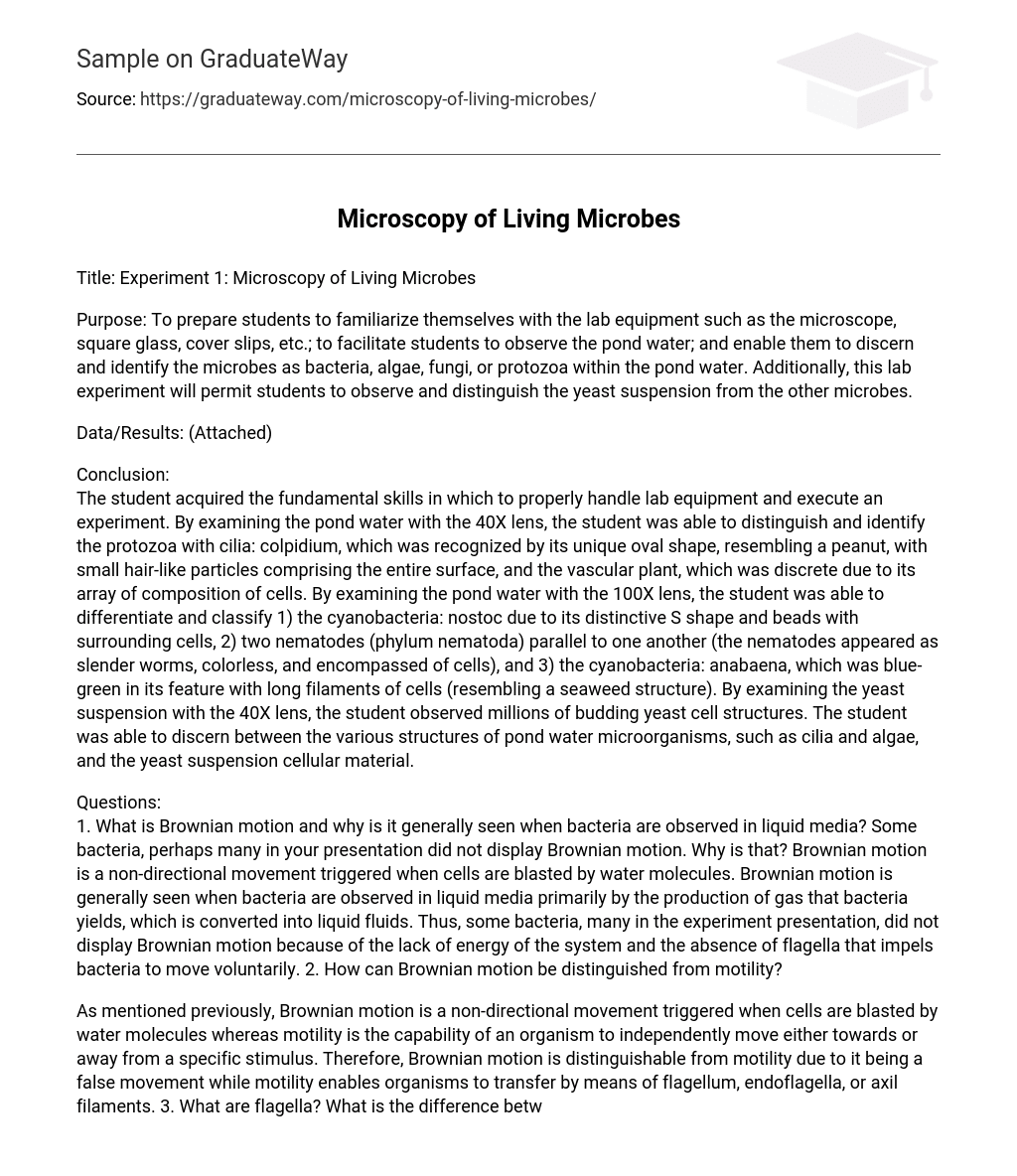The text aims to clarify the purpose…
The aim of this lab is to familiarize students with a variety of lab equipment, such as microscopes, square glass, and cover slips. The main focus is on observing pond water and identifying various microbes within it, including bacteria, algae, fungi, and protozoa. Furthermore, the experiment will teach students how to differentiate yeast suspension from other types of microbes.
Conclusion
The student gained the essential skills to effectively handle laboratory equipment and conduct experiments. The student used a 40X lens to analyze pond water and successfully identified two organisms: colpidium, which has an oval shape resembling a peanut and is covered in hair-like particles, and a vascular plant with distinct cell composition. The student then used a 100X lens to further examine the pond water and distinguish between different organisms.
- the cyanobacteria: nostoc due to its distinctive S shape and beads with surrounding cells,
- two nematodes (phylum nematoda) parallel to one another (the nematodes appeared as slender worms, colorless, and encompassed of cells),
- the cyanobacteria: anabaena, which was blue-green in its feature with long filaments of cells (resembling a seaweed structure).
Using the 40X lens, the student observed numerous budding yeast cell structures in the yeast suspension. Additionally, the student distinguished between the different structures of microorganisms found in pond water, such as cilia and algae, and the cellular material present in the yeast suspension.
Questions
- What is Brownian motion and why is it generally seen when bacteria are observed in liquid media? Some bacteria, perhaps many in your presentation did not display Brownian motion. Why is that? Brownian motion is a non-directional movement triggered when cells are blasted by water molecules. Brownian motion is generally seen when bacteria are observed in liquid media primarily by the production of gas that bacteria yields, which is converted into liquid fluids. Thus, some bacteria, many in the experiment presentation, did not display Brownian motion because of the lack of energy of the system and the absence of flagella that impels bacteria to move voluntarily.
- How can Brownian motion be distinguished from motility? As mentioned previously, Brownian motion is a non-directional movement triggered when cells are blasted by water molecules whereas motility is the capability of an organism to independently move either towards or away from a specific stimulus. Therefore, Brownian motion is distinguishable from motility due to it being a false movement while motility enables organisms to transfer by means of flagellum, endoflagella, or axil filaments.
- What are flagella? What is the difference between bacterial flagella and eukaryotic flagella? Flagella are long protein structures responsible for most type of prokaryotic motility and also propel cells through liquid. Bacterial flagella, which are also referred to as prokaryotic flagella, are smaller than eukaryotic flagella and have a simple structure, are made up of protein flagellin that provides a mechanism of motility, are proton driven, and have a rotatory movement. On the other hand, eukaryotic flagella have a larger and more complex configuration, are composed of tubulin that delivers a mechanism of locomotion, are ATP driven, and have a bending movement.
- In wet mount preparations, is it possible to see eukaryotic flagella? Prokaryotic flagella? In wet mount preparations, it is possible to see eukaryotic flagella, but it is not possible to see prokaryotic flagella.
- Does crystal clear pond water contain living bacteria? What about air? Your finger? All things that are not sterile do contain living bacteria such as pond water, air, and fingers.





